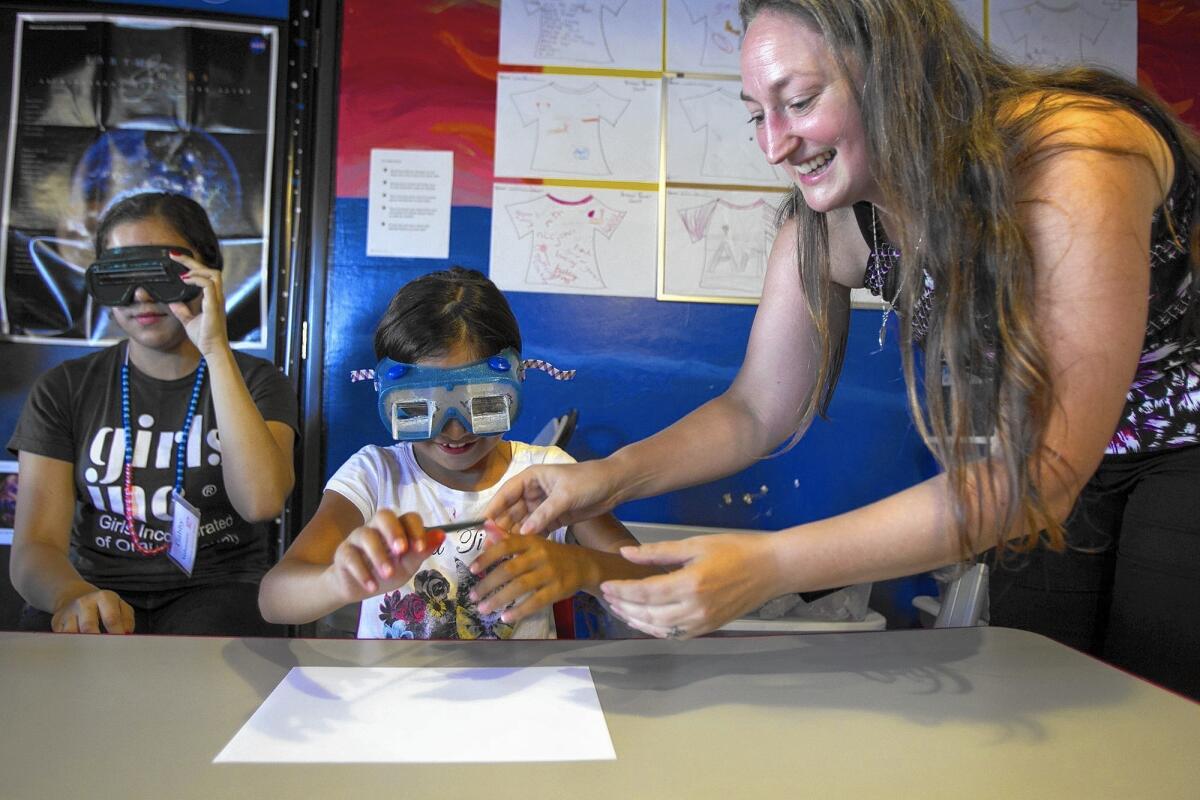Girls Inc. gets encouragement from Mars One candidate

Laura Smith-Velazquez, a candidate for the Mars One mission, works with Haley Rodriguez, 8, and Gabriela Jimenez, 16, as they attempt to draw a smiley face while wearing prism glasses at Girls Inc. on Friday.
- Share via
Girls Inc. of Orange County participants were treated to a special visit Friday from a Maryland woman who is a candidate for the Mars One mission.
Laura Smith-Velazquez spoke to about 40 girls at Girls Inc.’s downtown Costa Mesa youth and family center, encouraging them to pursue their own dreams of scientific careers and space exploration.
Smith-Velazquez, a 39-year-old engineer and pilot, is one of 100 semifinalists chosen from more than 200,000 applicants worldwide for Mars One, a Dutch-based organization that hopes to send crews to the Red Planet in 2026 to establish human settlements. In September, she will face additional competition against the other semifinalists. Eventually, 24 will be chosen to partake in 10 years of training before traveling on a one-way trip to Mars.
Smith-Velazquez told the girls about her own history, growing up in a small Michigan town as a Native American and one of six in a poor family. But Smith-Velazquez said, while other girls played with Barbies, she was interested in visiting the anthropology lab.
“It’s OK to follow that different path,” she said. “If you want to do something, you can do it.”
Her visit was organized by the Tustin office of Rockwell Collins, an international aerospace and defense firm that has given volunteer time and grants to Girls Inc. in the past, said Molly Quirk, Girls Inc. program services associate. Smith-Velazquez works in one of the firm’s Maryland offices.
Her speech was part of Girls Inc.’s STEM educational programming, which encourages the study of science, technology, engineering and mathematics.
During a question-and-answer session, Smith-Velazquez was able to answer both “sciencey” and not-so-scientific questions.
What is the temperature on Mars? It varies, she replied, and sometimes can get extremely cold.
Will she get to eat space ice cream? “Sure,” she said. “I can’t live without ice cream.”
“Is there Internet on Mars?” another girl asked. Yes, Smith-Velazquez said, via satellites that transmit back to Earth.
The answer that got Smith-Velazquez most excited was an inquiry along the lines of: “What if all the astronauts don’t fit in the spaceship?”
“That’s where I come in,” Smith-Velazquez replied, enthusiastically explaining how her engineering background includes design that will ensure all astronauts will get onboard.
What is the gravity like on Mars? About one-third of Earth’s, Smith-Velazquez said.
How about going to the bathroom? It’s similar enough to Earth, she said, but in space, “it’s a different story.”
